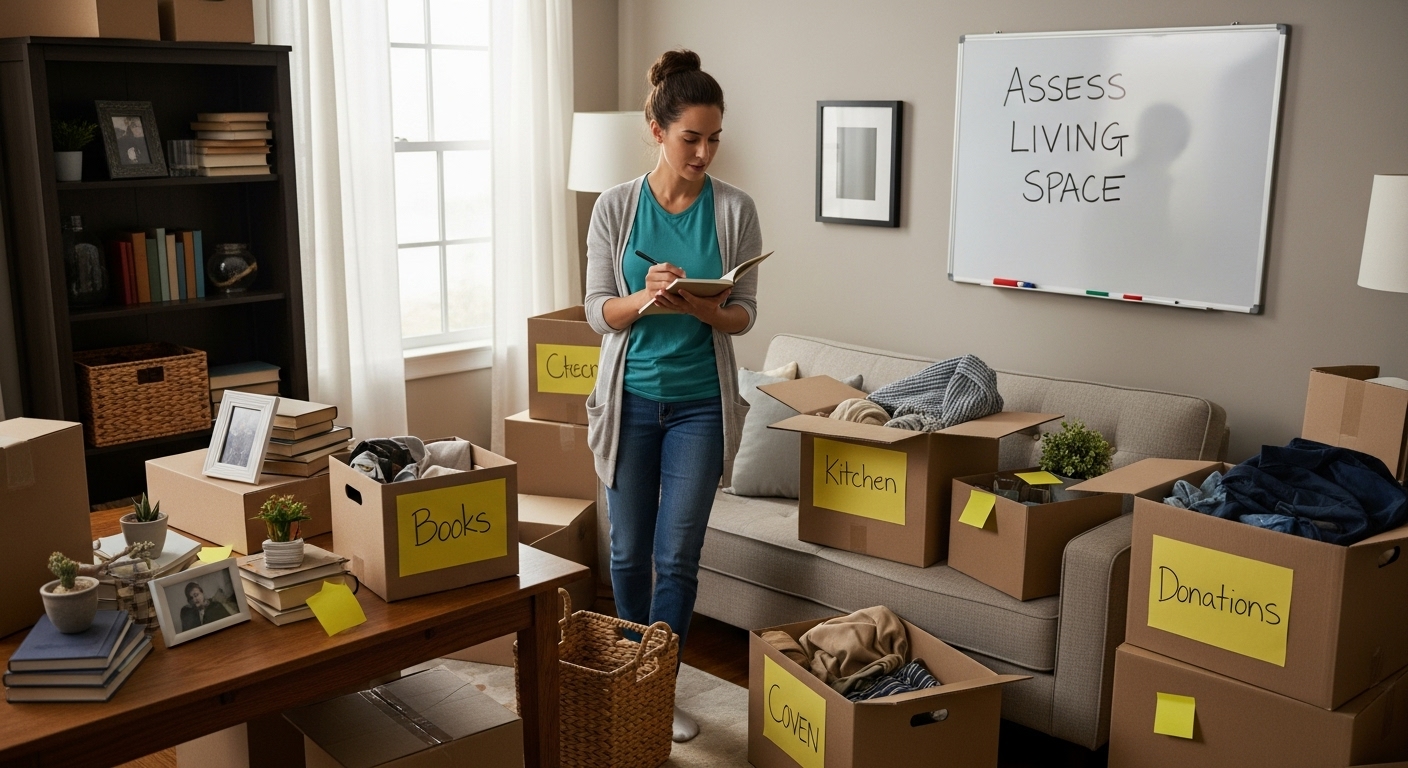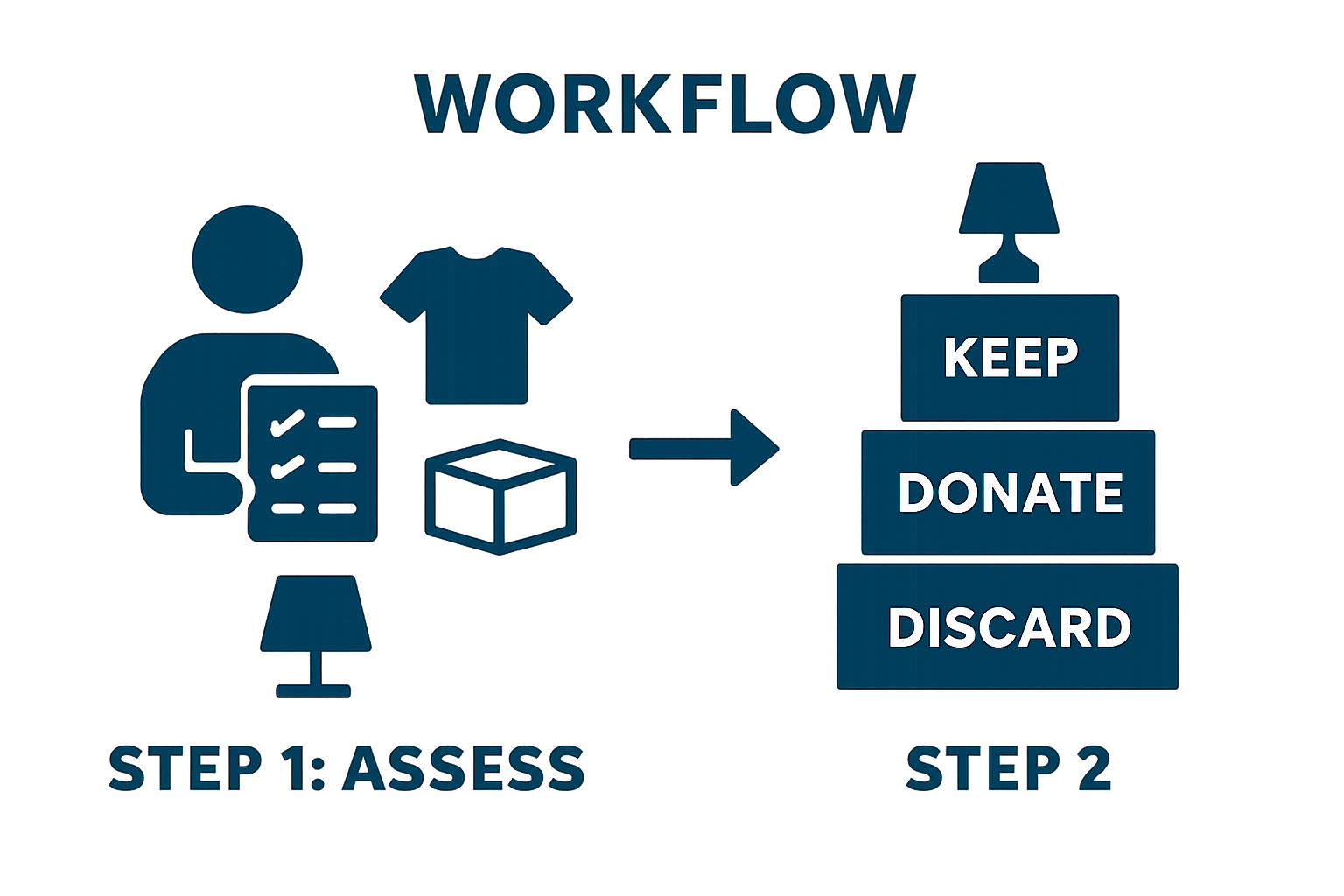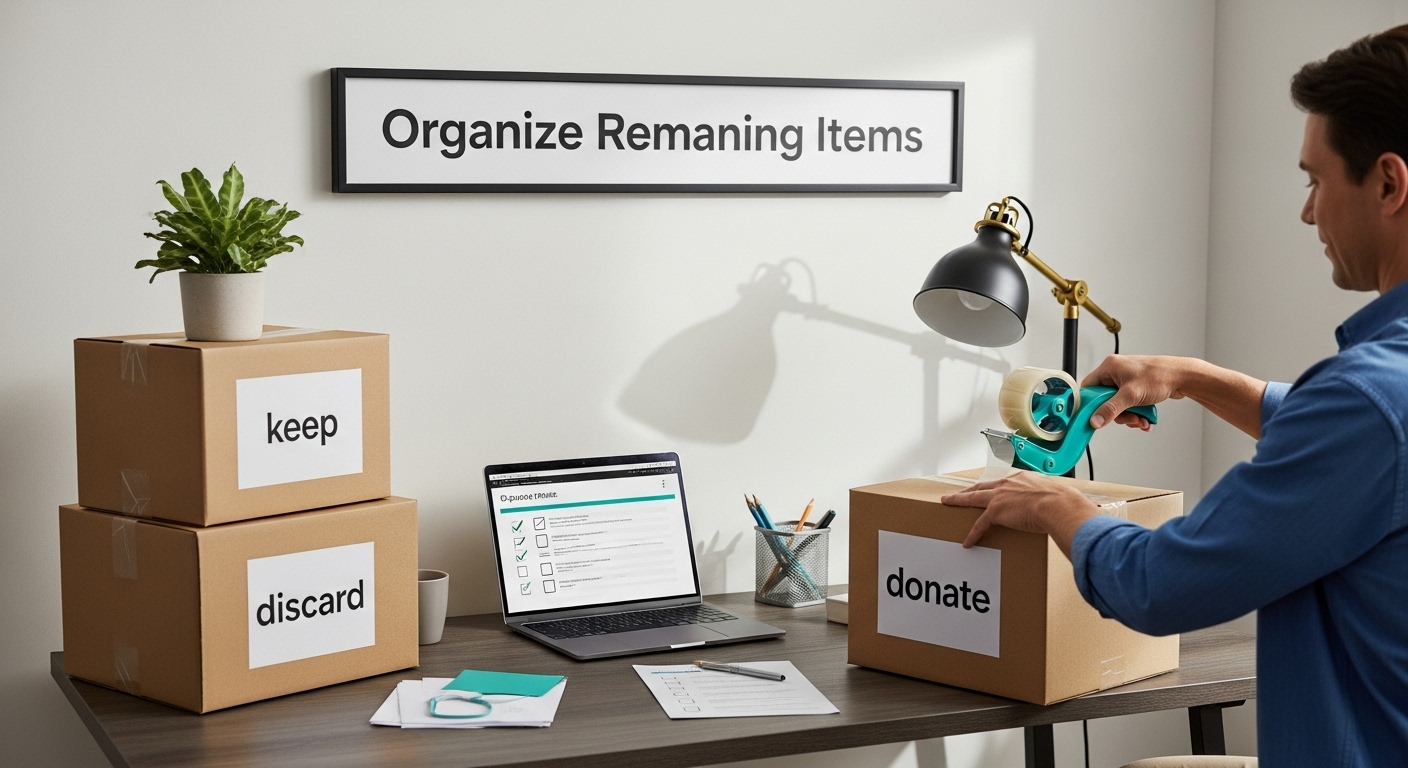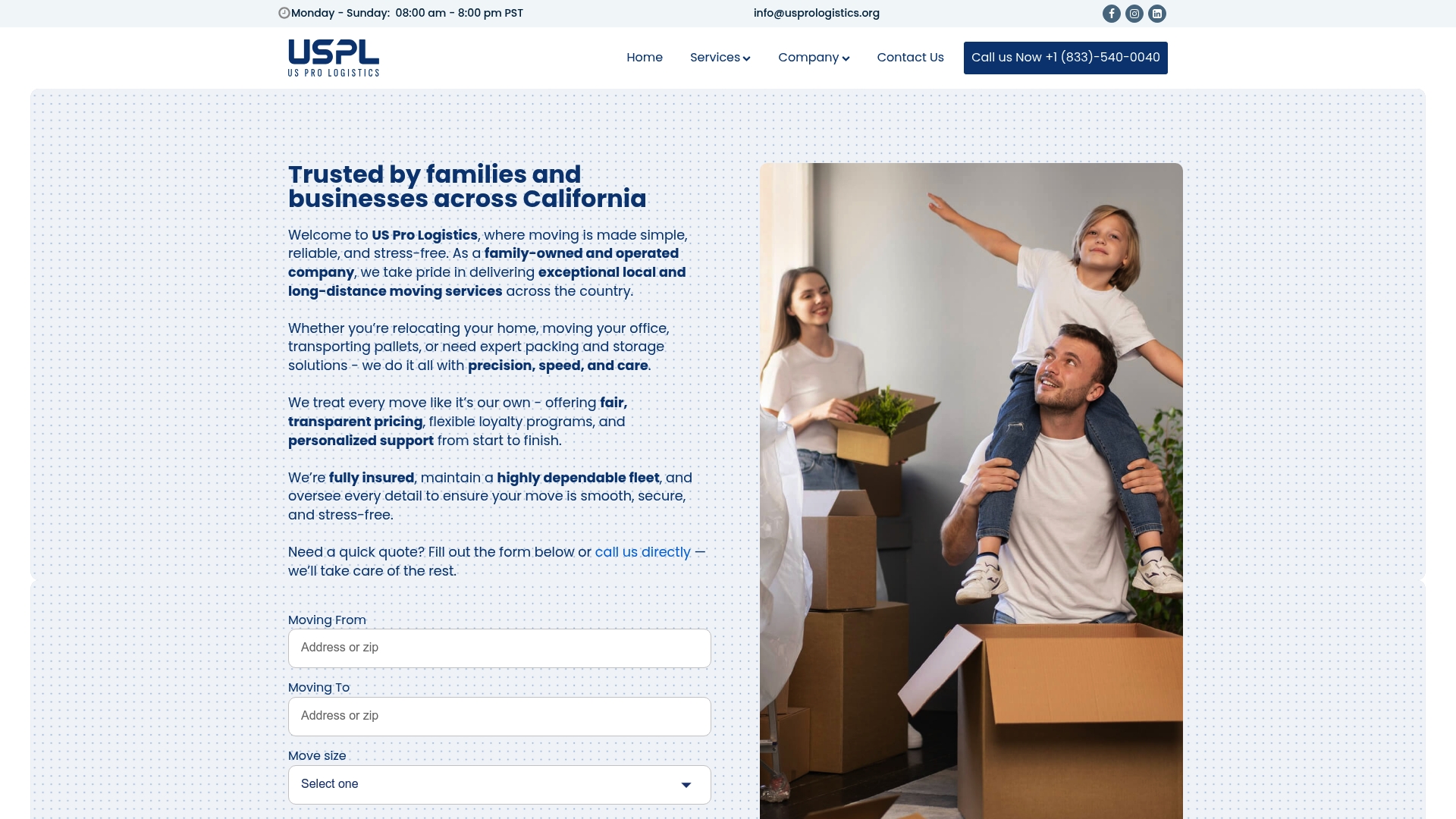
Moving to a new home can feel impossible when clutter has taken over every shelf, drawer, and closet. One look around and it seems like you need a whole moving truck just for the things you no longer use. Yet the truth is, more than 60 percent of moving stress comes from dealing with clutter before the first box is packed. The real secret to a smooth move is not where you start packing, but how you tackle what gets left behind.
| Key Point | Explanation |
|---|---|
| 1. Assess your living space thoroughly | Conduct a detailed evaluation of all areas to identify items to keep, donate, or discard. |
| 2. Categorize belongings systematically | Organize items by type, such as clothing and documents, to simplify decision-making on what to keep or let go. |
| 3. Develop a structured decluttering plan | Create a timeline with achievable goals and time blocks dedicated to decluttering tasks to stay organized and motivated. |
| 4. Execute decluttering in a strategic order | Start with easier items and gradually tackle more challenging categories, preventing burnout and maintaining momentum throughout the process. |
| 5. Prepare meticulously for the move | Research moving companies, create a budget, and pack strategically to ensure a smooth transition and reduce future stress. |
Before diving into the moving process, understanding the full landscape of your current living space is crucial for efficient decluttering. This initial assessment serves as the strategic foundation that will guide your entire relocation journey, helping you make informed decisions about what to keep, donate, or discard.
Begin by walking through each room with a critical eye, treating the process like a systematic inventory. Take a notebook or use your smartphone to document your findings. Examine every area thoroughly - from closets and drawers to shelves and storage spaces. Look beyond the visible surfaces and dig into hidden compartments where accumulated items often reside unnoticed.
As you assess, categorize items into clear mental groups. Some belongings will have clear emotional attachments, while others might be purely functional. According to the Mississippi State University Extension Service, identifying the type of clutter present helps in making more strategic decisions about what to keep or let go.
Consider creating three primary evaluation zones during your assessment:
Pay special attention to items with sentimental value. These can often become unexpected emotional roadblocks during decluttering. Ask yourself practical questions: When was the last time I used this? Does this item genuinely represent my current lifestyle? Would I replace this if it were lost?
Take measurements of larger furniture and rooms during this assessment. This information will prove invaluable when planning your move, helping you determine what will fit in your new space and potentially informing decisions about selling or donating oversized items.
By the end of your assessment, you should have a clear, comprehensive understanding of your current living space’s contents. This overview transforms an overwhelming moving process into a manageable, strategic plan, setting the stage for efficient and stress-free relocation.

After completing your initial assessment, the next critical phase of decluttering before a move is systematically categorizing your belongings. This step transforms your random collection of items into organized groups, making the subsequent decisions about what to keep, donate, or discard significantly more manageable.
Clothing and Personal Items form an excellent starting category. Pull every piece of clothing from closets, drawers, storage boxes, and even those forgotten corners of your home. Spread them out where you can see everything at once. This visual inventory helps you recognize duplicates, worn-out items, and pieces you haven’t worn in years. Be ruthless in your evaluation - if an item hasn’t been worn in the past year and doesn’t hold significant sentimental value, it’s time to let it go.
According to PBS SoCal, categorizing by type rather than by room can be a more effective decluttering strategy. This approach allows you to see the true volume of your possessions and make more objective decisions.
Move next to documents and paperwork, another critical category that often creates unnecessary moving stress. Create distinct piles for:
Furniture and large household items require a different approach. Measure each piece and consider its condition, sentimental value, and practicality in your new space. Some items might be more cost-effective to replace than move, especially if they’re older or worn.
Electronics and digital devices deserve special attention. Back up all important data, assess the functionality of each device, and decide whether to keep, donate, or responsibly recycle. Outdated or non-functioning electronics should never be simply thrown away due to potential environmental hazards.
As you categorize, maintain a running inventory. This list will become an invaluable tool for tracking your belongings, estimating moving costs, and ensuring nothing important gets left behind. By the end of this process, you should have clear, organized categories that make your subsequent decluttering decisions straightforward and stress-free.
Transforming your assessment and categorization into a structured plan is the crucial next step in preparing for a successful move. A well-crafted decluttering plan turns an overwhelming task into a manageable process, providing clear direction and motivation throughout your journey.
Time management becomes your greatest ally in this phase. Allocate specific blocks of time dedicated to decluttering, treating these sessions as important appointments with yourself. Most people find success by dedicating two to three hours per session, which prevents burnout while allowing substantial progress. According to AARP, setting realistic goals and specific deadlines is essential for maintaining momentum.
Start by creating a detailed timeline that breaks down your decluttering process into smaller, achievable segments. Assign particular categories or rooms to specific dates, ensuring you’re not trying to tackle everything simultaneously. Your plan should feel like a roadmap, with clear milestones that provide a sense of accomplishment as you progress.
Consider developing a tracking system to monitor your decluttering journey. This could be as simple as a physical checklist or a digital spreadsheet where you can mark completed tasks. Visual progress tracking can be incredibly motivating, helping you see how much you’ve accomplished and maintaining your commitment to the process.
Prepare your decluttering toolkit in advance to streamline the process:
Anticipate potential emotional challenges during this process. Some items will be harder to part with than others, especially those with sentimental value. Set personal boundaries and be compassionate with yourself. If an item truly feels irreplaceable, consider taking a photograph to preserve the memory while reducing physical clutter.
Establish a consistent rhythm for your decluttering sessions. Some people prefer weekend marathons, while others might find short, focused weekday evenings more effective. The key is finding a schedule that fits your lifestyle and energy levels.
By the end of creating your plan, you should have a clear, actionable timeline with specific tasks, allocated time blocks, and a systematic approach to reducing your belongings. This strategic blueprint will transform your move from a potentially stressful experience into an organized, manageable transition.
With your comprehensive plan in place, it’s time to transform strategy into action. The execution phase of decluttering is where your preparation truly pays off, turning potential chaos into a streamlined moving experience. Mental preparation is just as crucial as physical sorting - approach this process with patience and a clear mindset.
According to Winona State University, following a specific order can dramatically improve your decluttering efficiency. Begin with the easiest categories and gradually progress to more challenging items. This approach builds momentum and prevents early burnout.
Start with clothing, which tends to be less emotionally complicated. Empty every closet and drawer, creating a massive pile that might initially seem overwhelming. Sort each piece deliberately - create distinct piles for keeping, donating, selling, and discarding. Be honest about what you actually wear and what simply takes up space. Pro tip: If you haven’t worn an item in the past year, it’s likely time to let it go.
Move systematically through your categories, maintaining the order you established in your planning phase. Documents come next - shred unnecessary paperwork, digitize important records, and consolidate essential documents into a single, portable file system. This not only reduces physical clutter but also provides peace of mind during your move.
Set up your sorting zones with clear, labeled containers:
Approach sentimental items with compassion but firmness. These can often become emotional roadblocks in the decluttering process. Consider taking photographs of meaningful objects you’re choosing to release, creating a digital memory that doesn’t consume physical space.
For larger items like furniture, be pragmatic. Measure your new space and compare dimensions with your current pieces. Some furniture might not fit or suit your new environment. Consider selling, donating, or responsibly disposing of items that won’t serve you in the next chapter of your life.
By the end of this process, you should have significantly reduced your belongings, created organized piles ready for their next destination, and feel a sense of lightness and preparation. Your future self will thank you for the intentional, methodical approach to simplifying your move.

As you approach the final stage of decluttering before your move, verification and organization become paramount. This critical step transforms your sorted items into a well-structured, move-ready collection that minimizes stress and maximizes efficiency. Your goal is to create a precise, streamlined inventory of exactly what you’ll be taking to your new home.
According to AARP’s Smart Guide to Decluttering, setting specific and realistic goals is crucial during this verification process. Begin by revisiting each category of items you previously sorted, conducting a final, more rigorous evaluation. This is not about second-guessing your earlier decisions, but about ensuring absolute certainty about what you’re keeping.
Start with a comprehensive visual and physical inventory. Lay out all remaining items in a clear, well-lit space where you can see everything at once. This bird’s-eye view helps identify any redundancies, forgotten items, or pieces that might have slipped through previous sorting rounds. Photograph your organized items as both a record and a potential reference point for future unpacking.
Create a detailed inventory list that goes beyond simple categorization. Include key details for each significant item:
Pack items strategically, considering both their fragility and frequency of use. Designate special containers for valuables, important documents, and items you’ll need immediately upon arrival at your new residence. Use clear, labeled boxes that allow you to quickly identify contents without extensive searching.
Consider the weight and volume of your remaining items. If you find your collection is larger than anticipated, this is your final opportunity to make tough decisions about what truly needs to accompany you. Some items might be better sold, donated, or passed to family members rather than transported.
For electronics and digital devices, perform complete backups and create a separate, secure system for transporting critical data. Ensure chargers, cables, and accessories are packaged together to prevent loss during the move.
By the end of this verification process, you should have a meticulously organized collection of items, a comprehensive inventory list, and a clear understanding of exactly what you’re bringing to your new home.
Here is a checklist table summarizing key verification and organization tasks to complete before packing for your move.
| Step | Task | Purpose |
|---|---|---|
| 1 | Conduct a final inventory | Ensure all remaining items are accounted for and needed |
| 2 | Photograph organized items | Have a visual record for reference and unpacking |
| 3 | Create a detailed inventory list | Track item locations, conditions, and special needs |
| 4 | Pack items strategically | Prevents damage and ensures easy access upon arrival |
| 5 | Label boxes clearly | Speeds up unpacking and reduces confusion at destination |
| 6 | Evaluate item volume again | Identify last-minute items that can be downsized |
| 7 | Back up digital devices | Protect critical data and prevent information loss |
| This final step transforms decluttering from a daunting task into a precise, controlled transition that sets the stage for a smooth, stress-free move. |
With your items carefully sorted and organized, the next critical phase is preparing for the actual move. This step transforms your decluttering efforts into a strategic relocation plan, ensuring every aspect of your transition is carefully considered and executed. Mental and logistical preparation will be your greatest assets in navigating this complex process.
According to the Federal Motor Carrier Safety Administration, protecting yourself during the moving process is paramount. Begin by researching and selecting a reputable moving company. Request multiple quotes, verify their credentials, and read customer reviews thoroughly. Check their licensing and insurance status to protect your belongings during transit.
Budget planning becomes crucial at this stage. Moving expenses can quickly escalate, so create a comprehensive financial strategy that accounts for both expected and unexpected costs. Include expenses like packing materials, potential storage fees, transportation costs, and a contingency fund for unexpected challenges. Pro tip: Always allocate an additional 10-15% beyond your initial estimated budget to cover unforeseen expenses.
Organize your critical documents and valuables in a separate, easily accessible kit. This should include:
Prepare a detailed moving day survival kit that will keep you comfortable during the transition. Pack essential items you’ll need immediately upon arrival - think toiletries, a change of clothes, basic kitchen supplies, chargers, and important medications. Consider the first 24-48 hours in your new space and pack accordingly.
The following table organizes essential moving preparation tools and materials mentioned in the article, along with their uses, to make your final packing process seamless.
| Tool/Material | Purpose | Notes |
|---|---|---|
| Garbage bags | Discarding unusable items | Use sturdy bags for heavy or sharp objects |
| Donation boxes | Collecting items to donate | Clear labeling helps with sorting and drop-off |
| Packing tape & markers | Securing and labeling boxes | Mark contents and room destinations |
| Camera or smartphone | Documenting items and memories | Take photos for inventory or sentimental reasons |
| Cleaning supplies | Preparing spaces after decluttering | Wipe down emptied areas before packing up |
| Moving day survival kit | Keep essentials accessible | Include toiletries, clothes, medications, chargers |
| Labeled containers/boxes | Organizing packed belongings | Prevents mix-ups and speeds up unpacking |
Utilize technology to streamline your moving process. Create digital backups of important documents, use moving apps to track inventory and schedule tasks, and set up digital forwarding for your mail and important communications. This digital preparation prevents potential loss of critical information during the physical move.
Communicate proactively with your moving team. Provide clear, detailed instructions about fragile items, special handling requirements, and specific placement preferences in your new home. A well-informed moving team can significantly reduce stress and potential complications.
By the end of this preparation phase, you should have a comprehensive moving strategy, a financially planned transition, and a sense of control over the upcoming relocation. Your thorough decluttering and strategic preparation transform moving from a potentially chaotic experience into a manageable, organized journey.
Sorting, categorizing, and letting go of belongings can feel overwhelming, especially when you want a fresh start in your new home. As highlighted in our article, successful decluttering is about planning, smart organizing, and making tough decisions. But the process does not end when the boxes are packed. You need a moving partner who understands the importance of these details and treats your belongings with care every step of the way.

Let US Pro Logistics help you turn your well-organized plan into a seamless relocation. Discover how our personalized residential and commercial moving services, secure storage options, and transparent quotes support your decluttering efforts. If you are ready to move stress-free and enjoy support designed for your needs, visit US Pro Logistics today and request your quote. Take control of your move and experience a relocation that rewards the work you have already done.
Begin by assessing your current living space. Walk through each room, document your findings, and categorize items into keep, donate/sell, and discard zones for better organization.
Systematically categorize items by type, such as clothing, documents, furniture, and electronics. This allows for more objective decisions and helps identify what to keep, donate, or recycle.
Create a timeline outlining specific tasks for each category or room. Allocate dedicated blocks of time for decluttering sessions and prepare a toolkit with necessary supplies like garbage bags, donation boxes, and packing materials.
Approach sentimental items with a careful mindset. Consider taking photographs to preserve memories without keeping the physical item. Ask yourself if the item serves a purpose in your current lifestyle to help make the decision clearer.
USDOT 3664256 This number is required for any company that operates commercial vehicles in interstate commerce (across state lines). It helps identify and track the safety performance and compliance of transportation companies.
MC 1268070 This number is specifically for companies involved in the transportation of goods or passengers for hire across state lines. It’s necessary for carriers operating in the moving industry and ensures they are authorized to operate as interstate carriers.